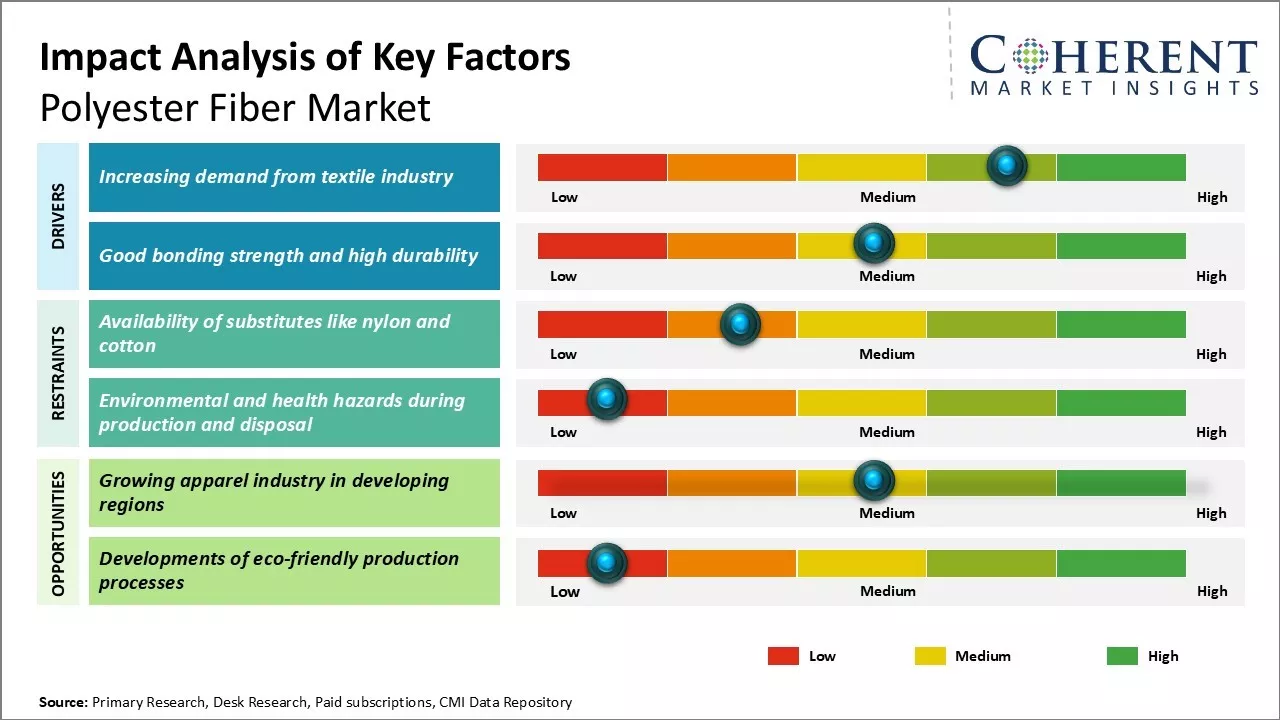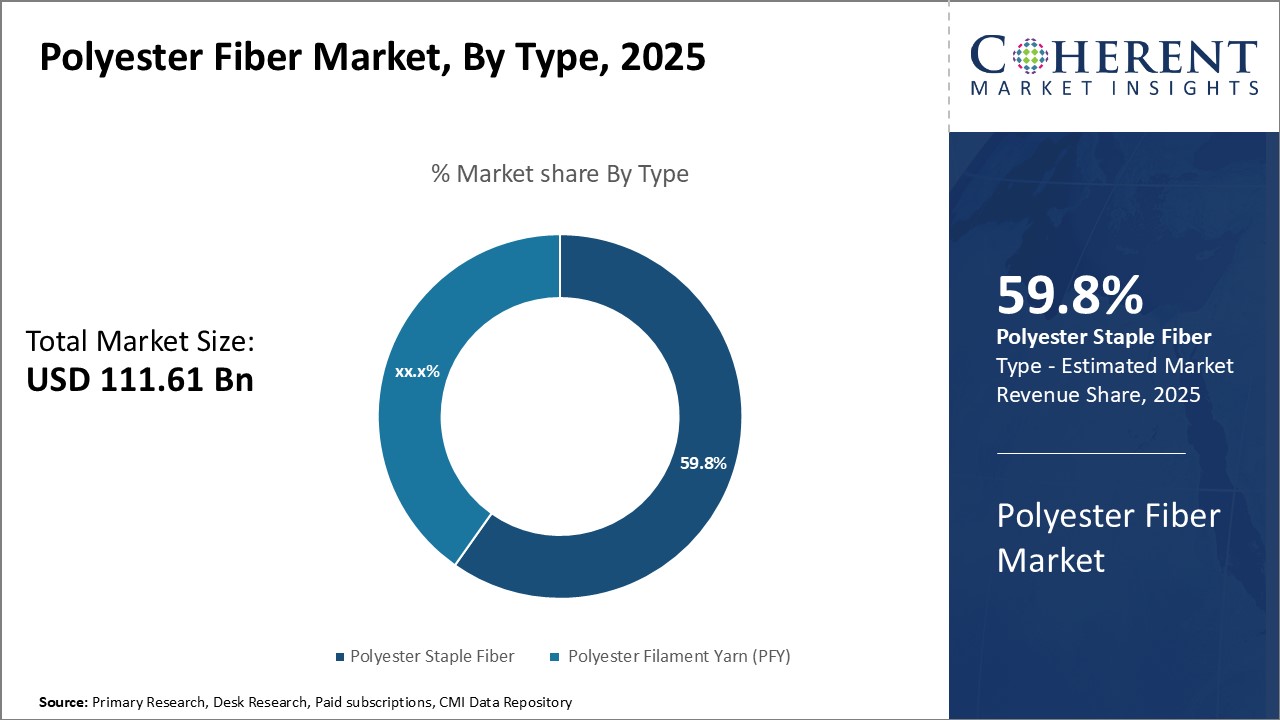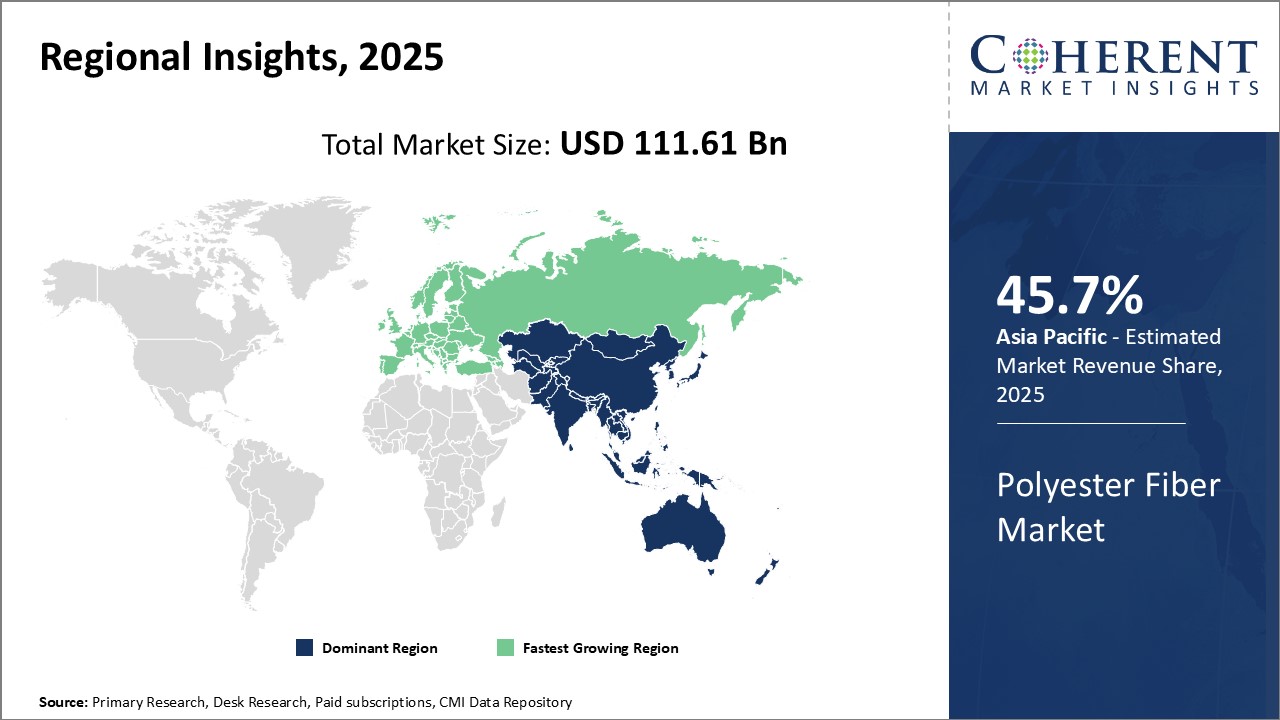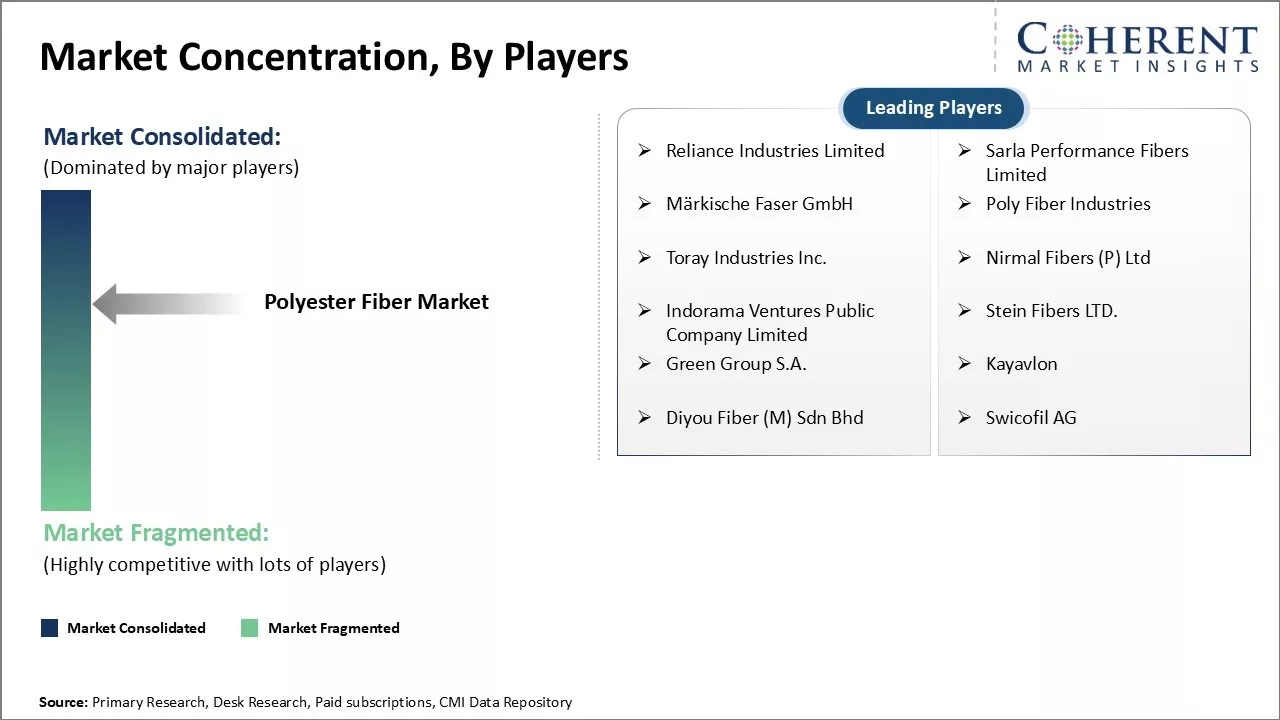Polyester Fiber Market Size and Trends
The polyester fiber market is estimated to be valued at USD 111.61 Bn in 2025 and is expected to reach USD 191.40 Bn by 2032, exhibiting a compound annual growth rate (CAGR) of 8.0% from 2025 to 2032.

Discover market dynamics shaping the industry: Download Free Sample
There has been a steady rise in the demand for polyester fibers owing to its superior properties as compared to natural fibers. Polyester fiber is highly durable, crease resistant, quick drying, and affordable. It is widely used in the apparel, home furnishing, and industrial applications. Rapid urbanization coupled with rising disposable income of consumers in developing nations is boosting the sales of apparel and indoor furnishings made from polyester fibers.

Discover high revenue pocket segments and roadmap to it: Download Free Sample
Insights By Type - Versatility drives the growth of Polyester Staple Fiber (PSF)
In terms of type, Polyester Staple Fiber (PSF) segment is expected to contribute 59.8% share of the market in 2025, owing to its versatile nature. PSF can be easily blended with other natural and synthetic fibers such as cotton, wool, and acrylic. This offers designers and manufacturers flexibility in fabric construction as well as properties. PSF also exhibits good washing durability, moisture resistance and affordability compared to natural fibers.
Insights By Source - Virgin polyesters dominate on purity and quality
In terms of source, the virgin segment is expected to contribute 50.8% share of the market in 2025, owing to perceived superior quality and purity. Customers associate virgin polyester with undiluted performance and lack of impurities compared to recycled variants. Virgin polyester offers consistency in chemical composition, color, and material properties. This consistency allows predictable manufacturing outcomes.
Insights By Grade - Superior properties of PET polyester boost its popularity
In terms of grade, Polyethylene Terephthalate (PET) polyester segment is expected to contribute 58.8% share in 2025, owing to its excellent tensile strength, thermal stability, moisture resistance, and dimensional stability. PET polyester maintains these properties over a wide range of temperatures without significant strength loss. Such high-performance attributes make PET polyester suitable for demanding applications in bottling, packaging, engineering plastics, and fiber industries.
Regional Insights

Need a Different Region or Segment? Download Free Sample
Regional Analysis: Polyester Fiber Market
Dominating Region: Asia Pacific
Asia pacific is expected to dominate the market in 2025 with an estimated share of 45.7%. Industrial presence and government support for synthetic textiles boost the polyester fiber demand. Countries like China, India, and Indonesia have large manufacturing bases and export-oriented industries which create steady demand.
Fastest-Growing Region: Europe
Europe region exhibits the fastest growth led by the U.K. and Germany. Economic reforms, trade agreements, and an emerging class are fueling stronger demand. Local manufacturers are also increasingly adopting new technologies to boost production capacities.
Polyester Fiber Market Outlook for Key Countries
China’s Market for Polyester Fiber Driven by Exports, Investments, and Sustainability Trends
China polyester fiber market remains resilient backed by strong exports and government initiatives to promote synthetic materials. Companies like Xingyi Group and Ruyi have made sizable investments in expanding capacities. Growing consumer awareness about sustainability is driving the demand for recycled polyester and eco-friendly production processes.
Textile Clusters, Investments, and Export Potential Drive India’s Market Growth
India's polyester fiber market growth is supported by robust textile industry clusters and a booming apparel sector catering to global brands. Aditya Birla Group and Indorama Ventures are notable domestic players. Initiatives like Production-Linked Incentive (PLI) scheme are encouraging investment in the synthetic fiber sector. According to IBEF data reported in October 2025, India is the world's 3rd largest exporter of Textiles and Apparel. India ranks among the top five global exporters in several textile categories, with exports expected to reach US$ 100 Bn.
Innovation, Sustainability, and Growth in European Consumer Apparel Demand through 2029
Germany is a leading producer of high-quality polyester fibers in Europe, emphasizing sustainable practices through investments in recycling technologies and bio-based fibers. The market is marked by continuous innovation in textiles, including smart and performance fabrics. According to Statista, European consumer spending on clothing and footwear is projected to rise over 18.5% from 2014 to 2029. This growth underscores the urgent need for European brands and retailers to adopt and develop sustainable materials, enhancing their competitiveness in the market.
Sustainability Trends, Trade Challenges, and Growing Demand for Recycled Materials in the U.K.
The U.K. polyester fiber market serves various applications including apparel, home textiles, and industrial uses. Growing consumer awareness about sustainability is driving the demand for recycled polyester and eco-friendly production processes. The industry is navigating new trade regulations and supply chain challenges, which could impact pricing and availability.
Market Concentration and Competitive Landscape

Get actionable strategies to beat competition: Download Free Sample
Top Strategies Followed by Polyester Fiber Market Players
- Established players focus heavily on research and development to create innovative new products. Leading companies invest extensively in R&D to develop high-performance polyester fibers with enhanced durability, flexibility and other desirable properties. Strategic partnerships are also important. Large players frequently form alliances with other major industry participants and original equipment manufacturers to strengthen their market position and distribution networks.
- Mid-level players emphasize cost-effective solutions to appeal to price-sensitive consumers. They strive to deliver quality polyester fiber products at affordable price points. Collaborations are also a major focus. Companies form partnerships to boost technology, expand production capabilities, and increase market visibility.
- Small-scale players smaller players highlight niche specialization, targeting specialized market segments with unique fiber varieties or innovative materials. Some focus on adopting cutting-edge technologies to differentiate their offerings and remain competitive. Local alliances with startups and regional manufacturers help small companies gain entry into new regional polyester fiber markets.
Emerging Startups in the Polyester Fiber Market
Many startups are developing advanced technologies with the potential to significantly impact the polyester fiber industry. Some examples include companies creating smart polyester sensors and artificial intelligence solutions for industrial applications. These innovative technologies could transform production processes and drive new market opportunities.
Sustainability is another major focus area for startup innovators. Several new companies are bringing eco-friendly polyester fibers and recycled materials to market. Their contributions will be important for reducing the industry's environmental footprint over the long run.
Startups also aim to meet niche market needs not addressed by larger players. Through collaborations with other firms and institutions, they drive technological advancement in specialized polyester fiber varieties. This supports the development of innovative solutions tailored for underserved applications and customer segments.
Key Takeaways from Analyst
- The polyester fiber market growth is driven by increasing demand from the apparel industry where polyester is widely used as it offers advantages like durability, stain resistance, and easy maintenance over cotton. Asia Pacific currently dominates the market owing to rising industrialization and growing middle-class population in countries like China and India which are boosting the apparel sector. High demand for polyester from Asian textile hubs like China and India is likely to sustain the region's dominance in the future as well.
- However, factors like availability of low-cost alternatives and stringent environmental regulations regarding plastic waste generation pose threats to market growth. Some key players are shifting focus towards the production of recycled polyester using plastic waste to overcome such restraints and capitalize on the opportunity of sustainable fibers. Man-made cellulosic fibers like viscose and modal are emerging as alternatives due to better moisture absorbency and breathability, which could hamper polyester demand from the apparel industry. Innovation in functional fabrics have opened doors for usage of technical polyester in segments like home textiles and automotive textiles besides apparel, creating new avenues for players.
Market Report Scope
Polyester Fiber Market Report Coverage
| Report Coverage | Details | ||
|---|---|---|---|
| Base Year: | 2024 | Market Size in 2025: | USD 111.61 Bn |
| Historical Data for: | 2020 To 2024 | Forecast Period: | 2025 To 2032 |
| Forecast Period 2025 to 2032 CAGR: | 8.0% | 2032 Value Projection: | USD 191.40 Bn |
| Geographies covered: |
|
||
| Segments covered: |
|
||
| Companies covered: |
Reliance Industries Limited, Sarla Performance Fibers Limited, Märkische Faser GmbH, Poly Fiber Industries, Toray Industries Inc., Nirmal Fibers (P) Ltd, Indorama Ventures Public Company Limited, Stein Fibers LTD., Green Group S.A., Kayavlon, Diyou Fiber (M) Sdn Bhd, and Swicofil AG |
||
| Growth Drivers: |
|
||
| Restraints & Challenges: |
|
||
Uncover macros and micros vetted on 75+ parameters: Get instant access to report
Market Dynamics
Market Driver - Increasing demand from textile industry
The global textile industry has experienced significant growth, driven by rising demand from emerging economies. Polyester fibers are now essential in fashion and home textiles, with products like clothing, home furnishings, and upholstery relying heavily on them. According to the UN Comtrade Database, global imports of polyester yarn rose by over 13.5% from 2020 to 2021. This growth is largely fueled by surging demand from leading garment producers in Asia, including China, India, Bangladesh, and Vietnam, which serve both domestic and international markets.
Market Challenge - Availability of substitutes like nylon and cotton
The availability of substitute materials like nylon and cotton presents a significant challenge for the polyester fiber market. Nylon offers high strength and durability, while cotton remains a popular alternative for apparel and home textiles. According to the World Trade Statistical Review 2022 by the WTO, global cotton trade grew by 20% in 2021 compared to 2019 levels, driven by new investments in cotton production and improved supply chains, particularly in India and Brazil, which boosted exports.
Market Opportunity - Growing apparel industry in developing regions
The apparel industry is rapidly expanding in developing regions like Asia Pacific and Africa, fueled by rising disposable incomes and growing fashion awareness, especially in India, Indonesia, and Vietnam. Polyester fibers are commonly used for affordable clothing such as shirts, trousers, and dresses due to their low cost and ease of production. The World Bank projects that by 2030, developing countries will account for nearly 45% of global GDP, highlighting the significant potential for polyester to meet the increasing textile demand in these markets.
Market Segmentation
- Type Insights (Revenue, USD Bn, 2020 - 2032)
-
- Polyester Staple Fiber (PSF)
- Polyester Filament Yarn (PFY)
- Source Insights (Revenue, USD Bn, 2020 - 2032)
-
- Virgin
- Recycled And Blended
- Others
- Grade Insights (Revenue, USD Bn, 2020 - 2032)
-
- Polyethylene Terephthalate (PET) Polyester
- PCDT Polyester
- Application Insights (Revenue, USD Bn, 2020 - 2032)
-
- Apparel
- Home textiles
- Carpets And Rugs
- Non-woven Fabrics
- Others
- Regional Insights (Revenue, USD, 2020 - 2032)
- North America
- U.S.
- Canada
- Latin America
- Brazil
- Argentina
- Mexico
- Rest of Latin America
- Europe
- Germany
- U.K.
- Spain
- France
- Italy
- Russia
- Rest of Europe
- Asia Pacific
- China
- India
- Japan
- Australia
- South Korea
- ASEAN
- Rest of Asia Pacific
- Middle East
- GCC Countries
- Israel
- Rest of Middle East
- Africa
- South Africa
- North Africa
- Central Africa
- North America
- Key Players Insights
- Reliance Industries Limited
- Sarla Performance Fibers Limited
- Märkische Faser GmbH
- Poly Fiber Industries
- Toray Industries Inc.
- Nirmal Fibers (P) Ltd
- Indorama Ventures Public Company Limited
- Stein Fibers LTD.
- Green Group S.A.
- Kayavlon
- Diyou Fiber (M) Sdn Bhd
- Swicofil AG
Share
Share
About Author
Yash Doshi is a Senior Management Consultant. He has 12+ years of experience in conducting research and handling consulting projects across verticals in APAC, EMEA, and the Americas.
He brings strong acumen in helping chemical companies navigate complex challenges and identify growth opportunities. He has deep expertise across the chemicals value chain, including commodity, specialty and fine chemicals, plastics and polymers, and petrochemicals. Yash is a sought-after speaker at industry conferences and contributes to various publications on topics related commodity, specialty and fine chemicals, plastics and polymers, and petrochemicals.
Missing comfort of reading report in your local language? Find your preferred language :
Transform your Strategy with Exclusive Trending Reports :
Frequently Asked Questions
EXISTING CLIENTELE
Joining thousands of companies around the world committed to making the Excellent Business Solutions.
View All Our Clients
